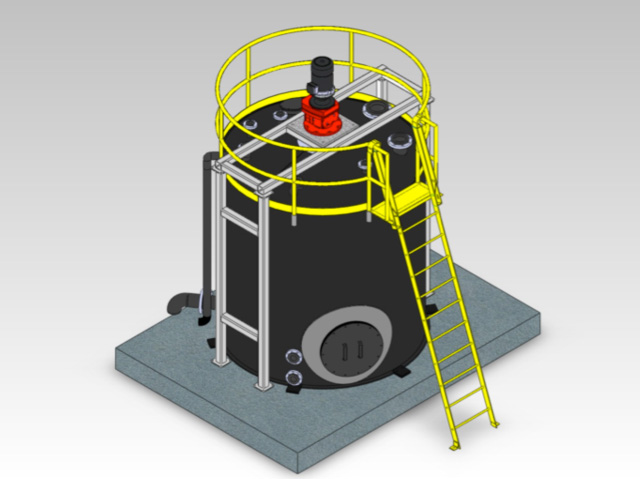The bulk storage of Hazardous Chemicals is a risky affair and is one of the reasons New Zealand’s Environmental Protection Agency (EPA) has such strict rules in place. These rules are covered by the HSNO Act 1996 which provides for […]
The bulk storage of Hazardous Chemicals is a risky affair and is one of the reasons New Zealand’s Environmental Protection Agency (EPA) has such strict rules in place. These rules are covered by the HSNO Act 1996 which provides for a series of regulations to manage the risks associated with hazardous substances.
The use of plastic tanks for storing hazardous substances is gaining popularity as it provides a cost effective solution in comparison to stainless, or fibreglass tanks. There are two choices when it comes to plastic tanks, fabricated, or rotationally moulded tanks. In this article we will consider what the primary differences between each tank type are, but to begin with, we will look at fabricated tanks.
Fabricated tanks are made from sheets of material typically 3.0m long x 1.5m wide. The most common materials used are Black HDPE, or PE100 and Polypropylene. The choice of material is dependent upon the intended application. The sheet thickness is very consistent, thereby eliminating the chance of weaknesses occurring due to wall section variations typically found with moulded tanks.
The sheets of material are welded together using specialised equipment to form the tank barrel, base and roof, to the dimensions required. The individual parts are then welded together to form the complete tank. The underlying construction methodology is very similar to the construction of stainless steel tanks which are also made from sheets of material. This method of manufacture allows for a great deal of flexibility in the design of the tanks within the limitations of the specified International standards and the HSNO Act.
A large variety of diameters and heights can be achieved to meet most requirements.
Rotationally moulded or “Roto” moulded tanks are formed via the use of a thin steel or cast aluminium mould. Powder equal to the desired weight of the tank is placed in the mould, which is then rotated and heated to allow the powder to distribute around the inside of the mould. After a defined period the heating is stopped and the mould cooled down to an appropriate level. The mould is then split apart and the moulded part removed. The quality of the finished moulded part is related to the design of the tool, the heating and temperature control systems and the control of the mould rotating system. These all effect the distribution of powder and therefore the wall section consistency. The typical materials used for rotational moulding are Linear Low Density Polyethylene (LLDPE), Low Denisty Polyethylene (LDPE) and Medium Density Polyethylene (MDPE). Special grades are often used for chemical storage applications. Rotational moulding powders have advanced a lot over the years however in general they have a lower density, lower molecular weight and lower strength when compared to PE100. When this is all taken into account rotationally moulded tanks have a maximum 10 year life compared to 25 years for fabricated tanks when used for chemical storage.
Below is a summary table comparing the key features of fabricated and rotomoulded tanks for use in storing hazardous chemicals. Overall fabricated tanks offer superior performance and flexibility in design, not to mention a service life 250% longer than rotomoulded tanks.
| Feature | Fabricated Tanks | Rotomoulded tanks |
|---|---|---|
| Design Life | 25 years | Maximum 10 years |
| Wall section specifications | Very consistent, sheets are manufactured to ± 0.1mm | Dependant on many factors but can be -15% to +30% from specification |
| Chemical Hazard Classification | Can store HSNO chemicals of class 5,6,8 & 9 | Can store HSNO chemicals of class 5,6,8 only |
| Seismic Stability | Due to strength of tanks, very simple arrangement and tanks held down by base only using non corrosive materials | Due to design limitations, are held down by complex metal structure attached to roof of tank |
| Fittings | 15NB to 250NB including 600NB side manways | 15NB to approx 100NB |
| Tank sizes | Few limitations, a variety of diameter and heights available to suit customer requirements from 300L to 60,000L | Limited to mould dimensions, from approx 500L to 25,000L |
| Max constant working temperature | PE100 – 45⁰CPolyporopylene – 70⁰C | Approx 35 – 40⁰C |
| Tank accessories | Mixers and mixer bridges, safety handrails, ladders and cages can all be added to meet customer requirements | N/A |
Fabricated tank showing the flexibility and some of tanks fittings and accessories that can be fitted to APD HazSure Chemical tanks.

For all your tank requirements contact APD for expert advice and friendly assistance.
Subscribe for regular updates, your email address is required for subscription.